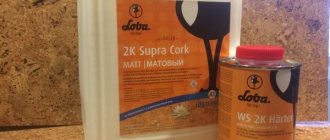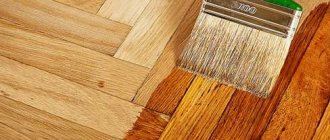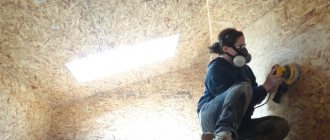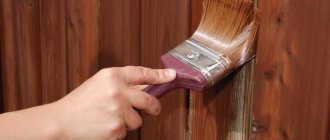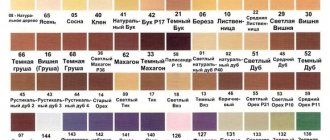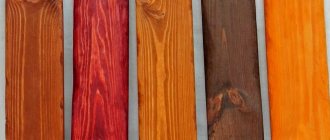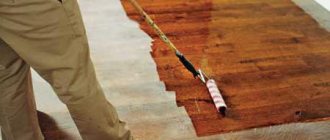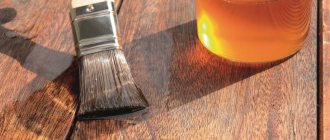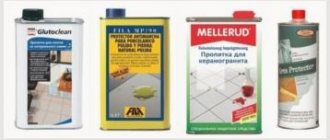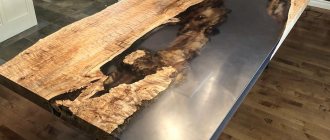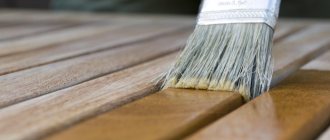Any person sooner or later faces the need for repairs. Today on the construction market there are many tools and materials that will help you update your interior or exterior on your own. One way is to paint interior wooden surfaces - window frames, doors, floors or even walls.
A wooden surface painted with drying oil does not always look attractive
Many people do not approach this issue seriously, so they buy the first available (that is, cheap) paint and start working without first preparing the surface, which becomes the main mistake.
If we are talking about a clumsy process with a roller, the result of which is visible on every fence, then the direction has been chosen correctly. But at the heart of any well-done finishing operation is attention to detail, which should be taken care of in advance. Otherwise, you can not only waste time, effort and money, but also completely ruin the consumables and the wooden object itself.
Therefore, it is important to take into account the nuances. For example, what to do if the wooden surface was previously covered with a coloring or strengthening solution: varnish, paint, impregnation or drying oil? The last composition is more problematic than the others, so, first of all, you need to figure out: with what and how to paint the drying oil previously applied to the surface of the wooden material?
Is it possible to apply stain to drying oil?
Since drying oil creates a film on the surface, the film is waterproof, then stain is applied first, possibly even in several layers. Next, complete drying (this is an important point) and after that we apply drying oil. Drying oil is best applied when warm.
Interesting materials:
How to connect a wireless gamepad? How to connect a wireless microphone to speakers? How do I connect my Jabra wireless headset? How to connect a 4tech wireless keyboard? How to connect a wireless intro keyboard? How to connect a wireless keyboard to a computer via Bluetooth? How to connect a Logitech wireless keyboard to a computer? How to connect a Trust wireless keyboard? How to connect Apple wireless headphones to MacBook? How to connect Jabra wireless headphones to iPhone?
Types of materials
Varnishes and drying oils belong to the group of film-forming substances used in the form of solutions. The final appearance of the treated surface depends on their type and composition. Varnishing allows you to protect or emphasize the structure of the surface being painted.
After drying, the coatings form a transparent, durable film; varnishes are often used to apply the base layer.
The range of varnish compositions is represented by a variety of types, methods of application and properties. Among them are:
- bitumen varnishes, which are made from special grades of bitumen, form a black film when dry and are resistant to reagents;
- oil compositions are solutions of vegetable oils with synthetic or natural resins; when dry they give a transparent yellow film;
- alcohol-based ones have a high drying rate and are produced by dissolving natural resins in alcohol;
- alkyd solutions - materials based on synthetic resins and are water resistant;
- alkyd-urea varnishes are used with hardeners and form a hard coating when dry;
- Cellulose nitrate materials are used to apply a protective coating to wood products;
- polyester;
- polyurethane coating materials;
- epoxy and petroleum polymer varnishes.
Drying oil for wood varies in composition, which determines the specifics of its use for impregnation and priming.
Natural drying oil is made from plant components of flax, hemp, sunflower with the use of special additives. Use as a primer helps to emphasize the beauty of the texture, the wood shows its pattern. Solvents are added to its composition to increase viscosity, and to improve the quality of the oil, it is oxidized and heated at high temperatures. They contain only 5% of a special drying additive that accelerates drying. Oxol consists of an oil component, a solvent and a drier. Thanks to this connection, it dries faster and its cost is low.
Composite synthetic material is produced from by-products of the oil refining industry. This type of product is not universal due to low quality. It is not recommended for treating interior spaces.
Compositions based on alkyd resins are of the highest quality. They are used for exterior and interior decoration.
Features and Specifications
Just 30 years ago, only drying oil was used in construction work. It was used to process wooden structures that were exposed to moisture and condensation. Now the situation has changed, the number of building materials and mixtures has increased. But there are those who to this day do not change their traditions.
By soaking in drying oil, the wood becomes more protected. A thin elastic and at the same time durable film appears on the surface of the structure, which protects the material from external influences (mold and mildew). Typically, at least two such layers are applied and then covered with paint.
Drying oil is openly used for interior work; it is also used for exterior use, but the treated surface areas are immediately covered with paints and varnishes.
If you apply it to any surface in a thick layer and leave it in the open air in a bright place, you will see that the liquid will begin to thicken. But once the product is spread over the surface in a thin layer, the drying oil will dry out, gradually turning into a durable coating. This ability of the material is achieved thanks to special acids (linoleic and linolenic) contained in vegetable oil.
To speed up the drying process, the drying oil contains seccatives - metal salts. The addition of such elements made it possible to achieve a significant reduction in drying time. The liquid dries within 6 to 36 hours. The guaranteed shelf life of the material is 3 years.
Main purpose
Considering the characteristics of the material, it is necessary to note why drying oil is needed:
- base for painting external structures;
- impregnation of internal structures (wall and ceiling cladding, flooring).
After treatment, it is necessary to give the coating time to saturate the inner layers of wood tissue. Drying times may vary, but you need to wait until it is completely dry. Next, the wooden covering, at the user’s request, is left in this form, or any oil paint is used.
The interaction of drying oil and oil paint will only strengthen the protective layer of wood. And also, the more drying oil is used, the less paint is consumed, isn’t that a plus?
You shouldn’t sit on the fence’s floors if you’ve just painted it, hoping that the impregnation is entirely natural products and will be absorbed in 5 seconds. Wood processing indoors is no less important than outdoors. Temperature changes, air humidity - all this does not have the best effect on the tree.
You can treat lining and floors with drying oil. However, do not forget that the composition must be absorbed until it dries completely, so entering the treated premises is strictly prohibited.
Remember that the main difference between internal and external processing is the lack of fresh air. If for outdoor rooms the natural “drying agent” is the sun and wind, then for internal treatment a maximum supply of fresh air will be required. This is necessary so that the surface in the room dries well in the shortest possible time, and the unpleasant odors, which even natural products have, disappear.
In addition to wood, drying oil and oxol are excellent for painting and preparing metals (at the priming stage). Drying oil can also be added to plaster - a kind of universal assistant to the builder.
How to tell if drying oil is completely dry and what to do if it doesn’t dry
The main sign that this material is completely dry is the absence of stickiness. However, in some cases, drying oil does not dry out even after 10 days. Most likely the reason is marriage. There is no point in waiting for such drying oil to dry out - it is better to clean it from the surface. One way to do this is with white spirit. However, if the material is deeply embedded in the wood, a plane may be required.
It is no secret that wooden surfaces treated with varnish or paint have a significant disadvantage - they become cold and lifeless. If you intend to preserve the beauty of texture, warmth and energy, we recommend that you pay attention to such a material for wood processing as drying oil.
Surface preparation
The importance of pre-treatment of the oiled surface has been discussed more than once. Only a short-sighted amateur who does not feel sorry for his wasted efforts and money on materials can omit the preparatory stages. A thrifty owner would prefer to do everything once, but thoroughly and well.
So, here is the sequence in which the processing work needs to be carried out:
- Clean surfaces from mechanical contamination: traces of old paint or putty, rust, lime, grease stains, soot and dust. Depending on the type of material (wood, concrete, metal), this should be done using a metal spatula or a brush with stiff bristles. Wash with soapy water. Let it dry.
- Sand or, if possible, plan the top layer (the latter is only for wood), using coarse sandpaper, a hand scraper or, better yet, a belt sander. Wash with water. Let it dry.
- Seal all chips and cracks with plaster or putty. Sand with fine-grit sandpaper. Wipe with a damp cloth.
- Prime. Let it dry. Sand it. Wipe with a damp cloth. Wait until completely dry.
- Apply the disinfectant composition no later than 6 hours after the previous stage. Let it dry.
How to properly treat wood before painting?
It is best to use Base and Impregnant primers - they provide maximum protection while preventing chemical protection. This is the so-called primary processing
and is carried out
before painting the wood
.
Interesting materials:
How many days is the fine with a 50 percent discount? How much experience should you have for car sharing? How long should a metal thermos keep warm? How long should the tachometer show at idle? How much should a Camry 40 generator produce? How much should the generator produce under load? How long should Power Bank 20000 be charged? How long should a power bank be charged? How much should the tint transmittance be? How much should the insurance company pay in case of an accident?
Semi-natural, combined, synthetic – areas of application of drying oils
Semi-natural drying oils are generally light brown in color. The resulting film on a wooden surface is characterized by hardness and good gloss, as well as fairly high water resistance. Basically, semi-natural compositions are used in combination with other paints and varnishes or as a primer. Like natural drying oils, semi-natural ones do not have sufficient strength for processing floor coverings.
Manufacturers add modifiers to combined compositions that improve their qualities necessary for the production and dilution of thick paints. Combined drying oils are also used for priming wooden surfaces before plastering or painting.
Do not forget that the liquid dries for at least a day - it is not recommended to apply a layer of paint or plaster until completely dry.
Synthetic compositions are used not so much for impregnation, but as a basis for diluting dark oil paints for exterior painting, as well as for priming metal, concrete and plastered surfaces. Synthetic drying oil is also used to prepare all kinds of putties and pastes.
Application method
In order to properly treat a wooden surface, you do not need to complete a painter’s course, but the basic principles of working with painting still need to be followed:
- Before using drying oil or oxol, the wooden surface is cleaned of dust, grease and thoroughly dried. Application to wet material is extremely ineffective.
- If the solution is too thick, you can dilute it with a solvent or nefras. Painting substances are used only after thorough mixing. No matter how fresh the jar is, stirring gives the drying oil structure oxygenation and reabsorption of the released oils.
- To cover wood with drying oil, use either a roller or brushes. Small details are painted with small brushes.
- Drying oil for wood and oxol with a maximum natural composition dry in approximately 24 hours. Since multiple layers must be used for greater effect, it is important to understand that it will take several days to thoroughly develop the detail. Synthetic drying oil dries in much less time.
When working with drying oil, it is important to protect the surface of your hands from contact with the material. If you do get dirty, carefully remove the top layer from the skin, while moistening it with vegetable oil. If the solution remains on the skin, you can remove the residue with a solvent, then wash your hands thoroughly with warm soapy water.
Conventional impregnation contains mainly chemical components. Drying oil consists of natural ingredients. Why waste effort, money and time on synthetics when you can protect your own health and wooden surfaces with natural materials?
When choosing a product, pay attention to the manufacturer. Today on the market you can find by-products that are produced under the name “drying oil”, but their composition is not very similar to it. Therefore, trust the work only to high-quality materials and well-known manufacturers, and your wooden products will serve for many years.
